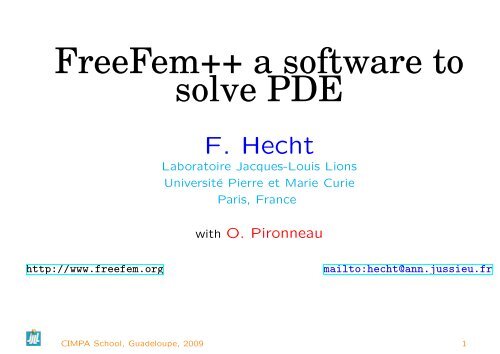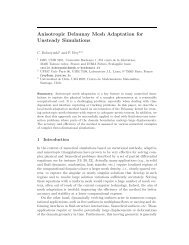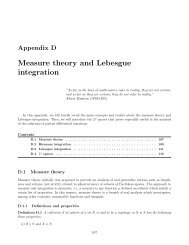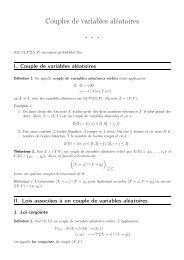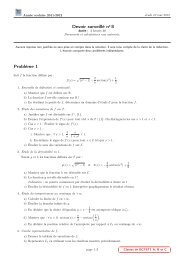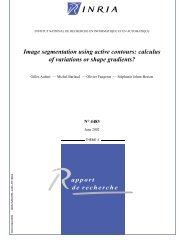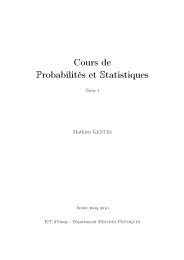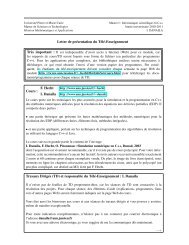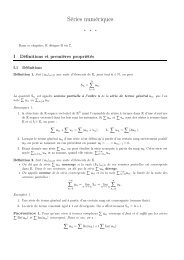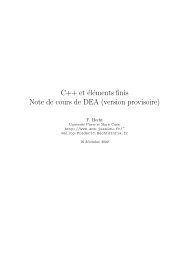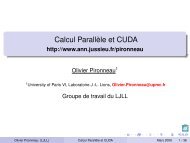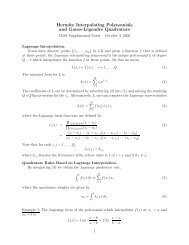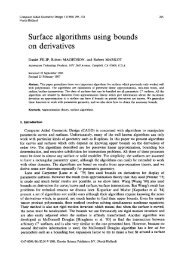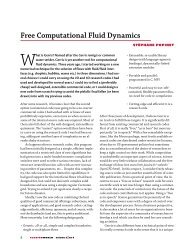FreeFem++ a software to solve PDE - Université Pierre et Marie ...
FreeFem++ a software to solve PDE - Université Pierre et Marie ...
FreeFem++ a software to solve PDE - Université Pierre et Marie ...
Create successful ePaper yourself
Turn your PDF publications into a flip-book with our unique Google optimized e-Paper software.
<strong>FreeFem++</strong> a <strong>software</strong> <strong>to</strong><br />
<strong>solve</strong> <strong>PDE</strong><br />
F. Hecht<br />
Labora<strong>to</strong>ire Jacques-Louis Lions<br />
<strong>Université</strong> <strong>Pierre</strong> <strong>et</strong> <strong>Marie</strong> Curie<br />
Paris, France<br />
with O. Pironneau<br />
http://www.freefem.org mail<strong>to</strong>:hecht@ann.jussieu.fr<br />
CIMPA School, Guadeloupe, 2009 1
– Introduction Freefem++<br />
– syntaxe<br />
– mesh generation<br />
– three formulations of Poisson<br />
problem<br />
– Poisson equation in 3D<br />
– variationnal form (Matrix and<br />
vec<strong>to</strong>r )<br />
– mesh adaptation with m<strong>et</strong>rics<br />
– error indica<strong>to</strong>r computation<br />
PLAN<br />
http://www.freefem.org/<br />
– an academic nolineair problem<br />
– a free boundary problem<br />
– exercise : minimal function problem<br />
– exercise : Optimal Hoven, problem<br />
– CFD 2d<br />
– Navier S<strong>to</strong>kes Incompressible in 3D<br />
– Domain decomposition example<br />
– Mortar M<strong>et</strong>hod in <strong>FreeFem++</strong><br />
– variationnal Inequation<br />
– Conclusion / Future<br />
CIMPA School, Guadeloupe, 2009 2
Introduction<br />
<strong>FreeFem++</strong> is a <strong>software</strong> <strong>to</strong> <strong>solve</strong> numerically partial differential equations<br />
(<strong>PDE</strong>) in IR 2 ) with finite elements m<strong>et</strong>hods. We used a user language <strong>to</strong> s<strong>et</strong><br />
and control the problem. The <strong>FreeFem++</strong> language allows for a quick<br />
specification of linear <strong>PDE</strong>’s, with the variational formulation of a linear<br />
steady state problem and the user can write they own script <strong>to</strong> <strong>solve</strong> no<br />
linear problem and time depend problem. You can <strong>solve</strong> coupled problem or<br />
problem with moving domain or eigenvalue problem, do mesh adaptation ,<br />
compute error indica<strong>to</strong>r, <strong>et</strong>c ...<br />
<strong>FreeFem++</strong> is a freeware and this run on Mac, Unix and Window<br />
architecture.<br />
CIMPA School, Guadeloupe, 2009 3
The main characteristics of <strong>FreeFem++</strong> I/II (2D)<br />
– Wide range of finite elements : linear and quadratic Lagrangian elements,<br />
discontinuous P1 and Raviart-Thomas elements, vec<strong>to</strong>rial element , minielement,<br />
...<br />
– Au<strong>to</strong>matic interpolation of data from a mesh <strong>to</strong> an other one, so a finite<br />
element function is view as a function of (x, y) or as an array.<br />
– Definition of the problem (complex or real value) with the variational form<br />
with access <strong>to</strong> the vec<strong>to</strong>rs and the matrix if needed<br />
– Discontinuous Galerkin formulation.<br />
CIMPA School, Guadeloupe, 2009 4
The main characteristics of <strong>FreeFem++</strong> II/II (2D)<br />
– Analytic description of boundaries, with specification by the user of the<br />
intersection of boundaries.<br />
– Au<strong>to</strong>matic mesh genera<strong>to</strong>r, based on the Delaunay-Voronoi algorithm.<br />
– load and save Mesh, solution<br />
– Mesh adaptation based on m<strong>et</strong>ric, possibly anisotropic, with optional au<strong>to</strong>matic<br />
computation of the m<strong>et</strong>ric from the Hessian of a solution.<br />
– LU, Cholesky, Crout, CG, GMRES, UMFPack sparse linear <strong>solve</strong>r ; eigenvalue<br />
and eigenvec<strong>to</strong>r computation with ARPACK.<br />
– Online graphics with OpenGL/GLUT, C++ like syntax.<br />
– Link with other soft : modulef, emc2, medit, gnuplot, ...<br />
– Dynamic linking <strong>to</strong> add func<strong>to</strong>nality.<br />
– Wide range of of examples : Navier-S<strong>to</strong>kes, elasticity, fluid structure, eigenvalue<br />
problem, Schwarz’ domain decomposition algorithm, residual error<br />
indica<strong>to</strong>r, ...<br />
CIMPA School, Guadeloupe, 2009 5
How <strong>to</strong> use<br />
on Unix build a ”yours.edp” file with your favorite edi<strong>to</strong>r : emacs, vi, nedit,<br />
<strong>et</strong>c. Enter <strong>FreeFem++</strong> yours.edp or <strong>FreeFem++</strong>-nw yours.edp <strong>to</strong> execute<br />
your script. Remark, this application <strong>FreeFem++</strong> must be in a direc<strong>to</strong>ry of<br />
your PATH shell variable.<br />
on Window, MacOs X build a ”yours.edp” file with your favorite text edi<strong>to</strong>r<br />
(raw text, not word text) : emacs, winedit, wordpad, bbedit, ... and click<br />
on the icon of the application <strong>FreeFem++</strong> and load you file via de open file<br />
dialog box or drag and drop the icon of your built file on the application<br />
<strong>FreeFem++</strong> icon.<br />
CIMPA School, Guadeloupe, 2009 6
Element of syntaxe I/II<br />
x,y,z , label, N.x, N.y, N.z , // current coordinate, label, normal<br />
int i = 0 ; // an integer<br />
real a=2.5 ; // a reel<br />
bool b=(a
Element of syntaxe : Like in C<br />
The key words are reserved<br />
The opera<strong>to</strong>r like in C exempt: ^ & |<br />
+ - * / ^ // where a^b= a b<br />
== != < > = & | // where a|b= a or b, a&b= a and b<br />
= += -= /= *=<br />
BOOLEAN: 0 false , �= 0 true<br />
// Au<strong>to</strong>matic cast for numerical value : bool, int, reel, complex , so<br />
func heavyside = real(x>0.) ;<br />
for (int i=0 ;i
Build Mesh 2D<br />
First a 10 × 10 grid mesh of unit square ]0, 1[ 2<br />
mesh Th1 = square(10,10) ; // boundary label:<br />
plot(Th1,wait=1) ; // 1 bot<strong>to</strong>m, 2 right, 3 <strong>to</strong>p, 4, left<br />
second a L shape domain ]0, 1[ 2 \[ 1 2 , 1[2<br />
border a(t=0,1.0){x=t ; y=0 ; label=1 ;} ;<br />
border b(t=0,0.5){x=1 ; y=t ; label=2 ;} ;<br />
border c(t=0,0.5){x=1-t ; y=0.5 ;label=3 ;} ;<br />
border d(t=0.5,1){x=0.5 ; y=t ; label=4 ;} ;<br />
border e(t=0.5,1){x=1-t ; y=1 ; label=5 ;} ;<br />
border f(t=0.0,1){x=0 ; y=1-t ;label=6 ;} ;<br />
plot(a(6) + b(4) + c(4) +d(4) + e(4) + f(6),wait=1) ; // <strong>to</strong> see the 6 borders<br />
mesh Th2 = buildmesh (a(6) + b(4) + c(4) +d(4) + e(4) + f(6)) ;<br />
G<strong>et</strong> a extern mesh<br />
mesh Th2("april-fish.msh") ;<br />
build with emc2, bamg, modulef, <strong>et</strong>c...<br />
CIMPA School, Guadeloupe, 2009 9
Laplace equation<br />
L<strong>et</strong> a domain Ω with a partition of ∂Ω in Γ2, Γe.<br />
Find u a solution in such that :<br />
Denote Vg = {v ∈ H 1 (Ω)/v |Γ2<br />
− ∆u = 1 in Ω, u = 2 on Γ2,<br />
= g} .<br />
∂u<br />
∂�n<br />
= 0 on Γe<br />
(1)<br />
The Basic variationnal formulation with is : find u ∈ V2(Ω) , such that<br />
�<br />
Ω<br />
∇u.∇v =<br />
�<br />
Ω 1v+<br />
�<br />
Γ<br />
∂u<br />
∂n v, ∀v ∈ V0(Ω) (2)<br />
CIMPA School, Guadeloupe, 2009 10
Laplace equation I/III<br />
The finite element m<strong>et</strong>hod is just : replace Vg with a finite element space,<br />
and the <strong>FreeFem++</strong> code :<br />
mesh Th("april-fish.msh") ;<br />
fespace Vh(Th,P1) ; // define the P1 EF space<br />
Vh u,v ;<br />
<strong>solve</strong> laplace(u,v,<strong>solve</strong>r=CG) =<br />
int2d(Th)( dx(u)*dx(v)+ dy(u)*dy(v) )<br />
- int2d(Th) ( 1*v)<br />
+ on(2,u=2) ; // int on γ2<br />
plot(u,fill=1,wait=1,value=0,ps="april-fish.eps") ;<br />
CIMPA School, Guadeloupe, 2009 11
Execute fish.edp<br />
Laplace equation / figure<br />
CIMPA School, Guadeloupe, 2009 12
Laplace equation (mixted formulation) II/III<br />
Now we <strong>solve</strong> −∆p = f on Ω and p = g on ∂Ω, with �u = ∇p<br />
so the problem becomes :<br />
Find �u, p a solution in a domain Ω such that :<br />
−∇.�u = f, �u − ∇p = 0 in Ω, p = g on Γ = ∂Ω (3)<br />
Mixted variationnal formulation<br />
find �u ∈ H div(Ω), p ∈ L 2 (Ω) , such that<br />
�<br />
Ω<br />
q∇.�u +<br />
�<br />
Ω<br />
p∇.�v + �u.�v =<br />
�<br />
Ω<br />
−fq +<br />
�<br />
Γ g�v.�n, ∀(�v, q) ∈ H div × L 2<br />
CIMPA School, Guadeloupe, 2009 13
Laplace equation (mixted formulation) II/III<br />
mesh Th=square(10,10) ;<br />
fespace Vh(Th,RT0) ; fespace Ph(Th,P0) ;<br />
Vh [u1,u2],[v1,v2] ; Ph p,q ;<br />
func f=1. ;<br />
func g=1 ;<br />
problem laplaceMixte([u1,u2,p],[v1,v2,q],<strong>solve</strong>r=LU) = //<br />
int2d(Th)( p*q*1e-10 + u1*v1 + u2*v2<br />
+ p*(dx(v1)+dy(v2)) + (dx(u1)+dy(u2))*q )<br />
- int2d(Th) ( -f*q)<br />
- int1d(Th)( (v1*N.x +v2*N.y)*g) ; // int on gamma<br />
laplaceMixte ; // the problem is now <strong>solve</strong>d<br />
plot([u1,u2],coef=0.1,wait=1,ps="lapRTuv.eps",value=true) ;<br />
plot(p,fill=1,wait=1,ps="laRTp.eps",value=true) ;<br />
Execute LaplaceRT.edp<br />
CIMPA School, Guadeloupe, 2009 14
Laplace equation (Garlerking discutinous formulation) III/III<br />
// <strong>solve</strong> −∆u = f on Ω and u = g on Γ<br />
macro dn(u) (N.x*dx(u)+N.y*dy(u) ) // def the normal derivative<br />
mesh Th = square(10,10) ; // unite square<br />
fespace Vh(Th,P2dc) ; // Discontinous P2 finite element<br />
// if pena = 0 => Vh must be P2 otherwise we need some penalisation<br />
real pena=0 ; // a param<strong>et</strong>er <strong>to</strong> add penalisation<br />
func f=1 ; func g=0 ;<br />
Vh u,v ;<br />
problem A(u,v,<strong>solve</strong>r=UMFPACK) = //<br />
int2d(Th)(dx(u)*dx(v)+dy(u)*dy(v) )<br />
+ intalledges(Th)( // loop on all edge of all triangle<br />
( jump(v)*average(dn(u)) - jump(u)*average(dn(v))<br />
+ pena*jump(u)*jump(v) ) / nTonEdge )<br />
- int2d(Th)(f*v)<br />
- int1d(Th)(g*dn(v) + pena*g*v) ;<br />
A ; // <strong>solve</strong> DG<br />
Execute LapDG2.edp<br />
CIMPA School, Guadeloupe, 2009 15
a corner singularity adaptation with m<strong>et</strong>ric<br />
The domain is an L-shaped polygon Ω =]0, 1[ 2 \[ 1 2 , 1]2 and the <strong>PDE</strong> is<br />
Find u ∈ H1 0 (Ω) such that − ∆u = 1 in Ω,<br />
The solution has a singularity at the reentrant angle and we wish <strong>to</strong> capture<br />
it numerically.<br />
example of Mesh adaptation<br />
CIMPA School, Guadeloupe, 2009 16
<strong>FreeFem++</strong> corner singularity program<br />
border a(t=0,1.0){x=t ; y=0 ; label=1 ;} ;<br />
border b(t=0,0.5){x=1 ; y=t ; label=2 ;} ;<br />
border c(t=0,0.5){x=1-t ; y=0.5 ;label=3 ;} ;<br />
border d(t=0.5,1){x=0.5 ; y=t ; label=4 ;} ;<br />
border e(t=0.5,1){x=1-t ; y=1 ; label=5 ;} ;<br />
border f(t=0.0,1){x=0 ; y=1-t ;label=6 ;} ;<br />
mesh Th = buildmesh (a(6) + b(4) + c(4) +d(4) + e(4) + f(6)) ;<br />
fespace Vh(Th,P1) ; Vh u,v ; real error=0.01 ;<br />
problem Probem1(u,v,<strong>solve</strong>r=CG,eps=1.0e-6) =<br />
int2d(Th)( dx(u)*dx(v) + dy(u)*dy(v)) - int2d(Th)( v)<br />
+ on(1,2,3,4,5,6,u=0) ;<br />
int i ;<br />
for (i=0 ;i< 7 ;i++)<br />
{ Probem1 ; // solving the pde problem<br />
Th=adaptmesh(Th,u,err=error) ; // the adaptation with Hessian of u<br />
plot(Th,wait=1) ; u=u ; error = error/ (1000^(1./7.)) ; } ;<br />
CIMPA School, Guadeloupe, 2009 17
load "Element_P3"<br />
mesh Th=square(1,1) ;<br />
mesh th=square(150,150) ;<br />
fespace Vh(Th,P2) ;<br />
Vh vi=0 ;<br />
for (int i=0 ;i
The 3d <strong>FreeFem++</strong> code (<strong>to</strong> day) :<br />
Laplace equation I 3d /III<br />
mesh3 Th("poisson.mesh") ;<br />
fespace Vh(Th,P13d) ; // define the P1 EF space<br />
Vh u,v ;<br />
macro Grad(u) [dx(u),dy(u),dz(u)] // EOM<br />
<strong>solve</strong> laplace(u,v,<strong>solve</strong>r=CG) =<br />
int3d(Th)( Grad(u)’*Grad(v) ) - int3d(Th) ( 1*v)<br />
+ on(2,u=2) ; // on γ2<br />
CIMPA School, Guadeloupe, 2009 19
The first 3d <strong>FreeFem++</strong> code :<br />
Matrix and vec<strong>to</strong>r<br />
mesh3 Th("poisson.mesh") ;<br />
fespace Vh(Th,P13d) ; // define the P1 EF space<br />
Vh u,v ;<br />
macro Grad(u) [dx(u),dy(u),dz(u)] // EOM<br />
varf vlaplace(u,v,<strong>solve</strong>r=CG) =<br />
int3d(Th)( Grad(u)’*Grad(v) ) + int3d(Th) ( 1*v)<br />
+ on(2,u=2) ; // on γ2<br />
matrix A= vlaplace(Vh,Vh,<strong>solve</strong>r=CG) ; // bilinear part<br />
real[int] b=vlaplace(0,Vh) ; // // linear part<br />
u[] = A^-1*b ;<br />
Execute Poisson3d.edp<br />
CIMPA School, Guadeloupe, 2009 20
A mathematical Poisson Problem with full Neumann BC. with<br />
1D lagrange multiplier<br />
The variationnal form is find (u, λ) ∈ V h × R such that<br />
∀(v, µ) ∈ V h × R a(u, v) + b(u, µ) + b(v, λ) = l(v), where b(u, µ) =<br />
�<br />
µudx<br />
mesh Th=square(10,10) ; fespace Vh(Th,P1) ; // P1 FE space<br />
int n = Vh.ndof, n1 = n+1 ;<br />
func f=1+x-y ; macro Grad(u) [dx(u),dy(u)] // EOM<br />
varf va(uh,vh) = int2d(Th)( Grad(uh)’*Grad(vh) ) ;<br />
varf vL(uh,vh) = int2d(Th)( f*vh ) ; varf vb(uh,vh)= int2d(Th)(1.*vh) ;<br />
matrix A=va(Vh,Vh) ;<br />
real[int] b=vL(0,Vh), B = vb(0,Vh) ;<br />
real[int] bb(n1),x(n1),b1(1),l(1) ; b1=0 ;<br />
matrix AA = [ [ A , B ] , [ B’, 0 ] ] ; bb = [ b, b1] ; // blocks<br />
s<strong>et</strong>(AA,<strong>solve</strong>r=UMFPACK) ; // s<strong>et</strong> the type of linear <strong>solve</strong>r.<br />
x = AA^-1*bb ; [uh[],l] = x ; // <strong>solve</strong> the linear systeme<br />
plot(uh,wait=1) ; // s<strong>et</strong> the value<br />
Execute Laplace-lagrange-mult.edp<br />
CIMPA School, Guadeloupe, 2009 21
An exercice : Oven problem<br />
Find the power on the 6 resis<strong>to</strong>rs of an oven such that the temperature is<br />
close as possible <strong>to</strong> a given temperature in the region 6.<br />
The equation are the stationary Head equation in 2d with classical Fourier<br />
boundary condition. the mesh of the domain :<br />
"oven.msh"<br />
IsoValue<br />
0<br />
1<br />
2<br />
3<br />
4<br />
5<br />
6<br />
7<br />
8<br />
l<strong>et</strong> call the up the solution of<br />
∇.K∇up =<br />
5�<br />
pi ∗ χi in Ω<br />
i=0<br />
u + K∇up.n = 0 on Γ = ∂Ω<br />
where χi is the characteristics function of the resistance i, K = 10<br />
in region 6, K = 1 over where.<br />
The problem is find the array p such that<br />
�<br />
p = argmin (up − 100) 2 dx<br />
CIMPA School, Guadeloupe, 2009 22<br />
Ω6
Some remark<br />
Xh[int] ur(6) ; // <strong>to</strong> s<strong>to</strong>re the 6 finite element functions Xh<br />
To day, <strong>FreeFem++</strong> as only linear <strong>solve</strong>r on sparse matrix. so a way <strong>to</strong> <strong>solve</strong> a<br />
full matrix problem is for example :<br />
real[int,int] AP(6,6) ; // a full matrix<br />
real[int] B(6),PR(6) ; // <strong>to</strong> array (vec<strong>to</strong>r of size 6)<br />
... bla bla <strong>to</strong> compute AP and B<br />
matrix A=AP ; // build sparse data structure <strong>to</strong> s<strong>to</strong>re the full matrix<br />
s<strong>et</strong>(A,<strong>solve</strong>r=CG) ; // s<strong>et</strong> linear <strong>solve</strong>r <strong>to</strong> the Conjuguate Gradient<br />
PR=A^-1*B ; // <strong>solve</strong> the linear system.<br />
The file name of the mesh is oven.msh, and the region numbers are 0 <strong>to</strong> 5 for<br />
the resi<strong>to</strong>r, 6 for Ω6 and 7 for the rest of Ω and the label of Γ is 1.<br />
CIMPA School, Guadeloupe, 2009 23
My solution, build the 6 basics function uei<br />
int nbresi<strong>to</strong>r=6 ; mesh Th("oven.msh") ;<br />
real[int] pr(nbresi<strong>to</strong>r+2), K(nbresi<strong>to</strong>r+2) ;<br />
K=1 ; K[regi]=10 ; // def K<br />
int regi=nbresi<strong>to</strong>r, rege=nbresi<strong>to</strong>r+1, lext=1 ;<br />
macro Grad(u) [dx(u),dy(u)] // EOM<br />
fespace Xh(Th,P2) ; Xh u,v ;<br />
int iter=0 ;<br />
problem Chaleur(u,v,init=iter)<br />
= int2d(Th)( Grad(u)’*Grad(v)* K[region]) + int1d(Th,lext)(u*v)<br />
+ int2d(Th)(pr[region]*v) ;<br />
Xh[int] ur(nbresi<strong>to</strong>r) ; // <strong>to</strong> s<strong>to</strong>re the 6 uei<br />
for(iter=0 ;iter
Computation of the optimal value<br />
real[int,int] AP(nbresi<strong>to</strong>r,nbresi<strong>to</strong>r) ;<br />
real[int] B(nbresi<strong>to</strong>r),PR(nbresi<strong>to</strong>r) ;<br />
Xh ui = 100 ;<br />
for(int i=0 ;i
For the Laplace problem<br />
Error indica<strong>to</strong>r<br />
−∆u = f in Ω, u = g on ∂Ω<br />
the classical error η K indica<strong>to</strong>r [C. Bernardi, R. Verfürth] are :<br />
�<br />
ηK =<br />
K h2K |(f + ∆uh)| 2 +<br />
∂K he|[ ∂uh ∂n ]|2<br />
where hK is size of the longest edge, he is the size of the current edge, n the<br />
normal.<br />
Theorem : This indica<strong>to</strong>r is optimal with Lagrange Finite element<br />
c0<br />
� �<br />
K<br />
η 2 K ≤ ||u − u h|| H1<br />
�<br />
�<br />
�<br />
≤ c1 η<br />
K<br />
2 K<br />
where c0 and c1 are two constant independent of h , if T h is a regular family<br />
of triangulation.<br />
CIMPA School, Guadeloupe, 2009 26
Test on an other problem :<br />
Error indica<strong>to</strong>r in <strong>FreeFem++</strong><br />
10 −10 u − ∆u = x − y in Ω,<br />
remark, the 10 −10 u term is just <strong>to</strong> fix the constant.<br />
We plot the density of error indica<strong>to</strong>r :<br />
fespace Nh(Th,P0) ;<br />
ρ K = η K<br />
|K|<br />
∂u<br />
∂n<br />
= 0 onΓ<br />
varf indica<strong>to</strong>r2(uu,<strong>et</strong>a) =<br />
intalledges(Th)( <strong>et</strong>a/lenEdge*square( jump( N.x*dx(u)+N.y*dy(u) ) ) )<br />
+ int2d(Th)( <strong>et</strong>a*square( f+dxx(u)+dyy(u) ) ) ;<br />
<strong>et</strong>a[] = indica<strong>to</strong>r2(0,Nh) ;<br />
Execute adaptindica<strong>to</strong>rP1.edp<br />
CIMPA School, Guadeloupe, 2009 27
M<strong>et</strong>ric / unit Mesh<br />
In Euclidean geom<strong>et</strong>ry the length |γ| of a curve γ of R d param<strong>et</strong>rized by γ(t)t=0..1<br />
is<br />
|γ| =<br />
� 1<br />
0<br />
�<br />
< γ ′ (t), γ ′ (t) >dt<br />
We introduce the m<strong>et</strong>ric M(x) as a field of d × d symm<strong>et</strong>ric positive definite<br />
matrices, and the length ℓ of Γ w.r.t M is :<br />
� 1 �<br />
ℓ = < γ ′ (t), M(γ(t))γ ′ (t) >dt<br />
0<br />
The key-idea is <strong>to</strong> construct a mesh where the lengths of the edges are<br />
close <strong>to</strong> 1 accordingly <strong>to</strong> M.<br />
CIMPA School, Guadeloupe, 2009 28
The main IDEA for mesh generation<br />
– The difficulty is <strong>to</strong> find a tradeoff be<strong>et</strong>ween the error estimate and the mesh<br />
generation, because this two work are strongty different.<br />
– To do that, we propose way based on a m<strong>et</strong>ric M and unit mesh w.r.t M<br />
– The m<strong>et</strong>ric is a way <strong>to</strong> control the mesh size.<br />
– remark : The class of the mesh which can be created by the m<strong>et</strong>ric, is very<br />
large.<br />
CIMPA School, Guadeloupe, 2009 29
Example of mesh<br />
f1 = (10 ∗ x 3 + y 3 ) + atan2(0.001, (sin(5 ∗ y) − 2 ∗ x))<br />
f2 = (10 ∗ y 3 + x 3 ) + atan2(0.01, (sin(5 ∗ x) − 2 ∗ y)).<br />
Enter ? for help Enter ? for help Enter ? for help<br />
CIMPA School, Guadeloupe, 2009 30
In dimension 2<br />
With the P 1 finite element the error interpolation is :<br />
||u − Πhu|| T ∞ ≤ 1<br />
2 sup (<br />
x,y,z∈T<br />
t �xy |H(z)| �xy )<br />
where |H| have the same eigenvec<strong>to</strong>rs and the eigenvalue of |H| is the abs of<br />
the eigenvalue of H,<br />
We take<br />
M = 1<br />
and where ε0 is the expected error.<br />
ε0<br />
CIMPA School, Guadeloupe, 2009 31<br />
|H|
Comparison : M<strong>et</strong>ric and error indica<strong>to</strong>r :<br />
example of m<strong>et</strong>ric mesh : u = yx 2 + y 3 + tanh(10 (sin(5y) − 2x)) and<br />
M = 50 |H(u)|<br />
DEMO I<br />
Execute aaa-adp.edp<br />
CIMPA School, Guadeloupe, 2009 32
An academic problem<br />
We propose the <strong>solve</strong> the following non-linear academic problem of<br />
minimization of a functional<br />
J(u) = 1<br />
2<br />
�<br />
Ω f(|∇u|2 ) − u ∗ b<br />
where u is function of H1 0 (Ω). and where f is defined by<br />
f(x) = a ∗ x + x − ln(1 + x), f ′ (x) = a + x<br />
1 + x , f ′′ (x) =<br />
1<br />
(1 + x) 2<br />
CIMPA School, Guadeloupe, 2009 33
<strong>FreeFem++</strong> definition<br />
mesh Th=square(10,10) ; // mesh definition of Ω<br />
fespace Vh(Th,P1) ; // finite element space<br />
fespace Ph(Th,P0) ; // make optimization<br />
the definition of f, f ′ , f ′′ and b<br />
real a=0.001 ;<br />
func real f(real u) { r<strong>et</strong>urn u*a+u-log(1+u) ; }<br />
func real df(real u) { r<strong>et</strong>urn a+u/(1+u) ;}<br />
func real ddf(real u) { r<strong>et</strong>urn 1/((1+u)*(1+u)) ;}<br />
Vh b=1 ; // <strong>to</strong> defined b<br />
CIMPA School, Guadeloupe, 2009 34
New<strong>to</strong>n Ralphson algorithm<br />
Now, we <strong>solve</strong> the problem with New<strong>to</strong>n Ralphson algorithm, <strong>to</strong> <strong>solve</strong> the<br />
Euler problem ∇J(u) = 0 the algorithm is<br />
u n+1 = u n − �<br />
∇ 2 J(u n ) � −1 ∇J(u n )<br />
First we introduce the two variational form vdJ and vhJ <strong>to</strong> compute<br />
respectively ∇J and ∇ 2 J<br />
CIMPA School, Guadeloupe, 2009 35
The variational form<br />
Ph ddfu,dfu ; // <strong>to</strong> s<strong>to</strong>re f ′ (|∇u| 2 ) and 2f ′′ (|∇u| 2 ) optimization<br />
// the variational form of evaluate dJ = ∇J<br />
// --------------------------------------<br />
// dJ = f’()*( dx(u)*dx(vh) + dy(u)*dy(vh)<br />
varf vdJ(uh,vh) = int2d(Th)( dfu *( dx(u)*dx(vh) + dy(u)*dy(vh) ) - b*vh)<br />
+ on(1,2,3,4, uh=0) ;<br />
// the variational form of evaluate ddJ = ∇ 2 J<br />
// hJ(uh,vh) = f’()*( dx(uh)*dx(vh) + dy(uh)*dy(vh)<br />
// + f’’()( dx(u)*dx(uh) + dy(u)*dy(uh) )<br />
// * (dx(u)*dx(vh) + dy(u)*dy(vh))<br />
varf vhJ(uh,vh) = int2d(Th)( dfu *( dx(uh)*dx(vh) + dy(uh)*dy(vh) )<br />
+ ddfu *(dx(u)*dx(vh) + dy(u)*dy(vh) )*(dx(u)*dx(uh) + dy(u)*dy(uh)))<br />
+ on(1,2,3,4, uh=0) ;<br />
CIMPA School, Guadeloupe, 2009 36
New<strong>to</strong>n Ralphson algorithm, next<br />
// the New<strong>to</strong>n algorithm<br />
Vh v,w ;<br />
u=0 ;<br />
for (int i=0 ;i
A Free Boundary problem , (phreatic water)<br />
L<strong>et</strong> a trapezoidal domain Ω defined in <strong>FreeFem++</strong> :<br />
real L=10 ; // Width<br />
real h=2.1 ; // Left height<br />
real h1=0.35 ; // Right height<br />
border a(t=0,L){x=t ;y=0 ;label=1 ;} ; // bot<strong>to</strong>m impermeable Γa<br />
border b(t=0,h1){x=L ;y=t ;label=2 ;} ; // right, the source Γ b<br />
border f(t=L,0){x=t ;y=t*(h1-h)/L+h ;label=3 ;} ; // the free surface Γ f<br />
border d(t=h,0){x=0 ;y=t ;label=4 ;} ; // Left impermeable Γ d<br />
int n=10 ;<br />
mesh Th=buildmesh (a(L*n)+b(h1*n)+f(sqrt(L^2+(h-h1)^2)*n)+d(h*n)) ;<br />
plot(Th,ps="dTh.eps") ;<br />
CIMPA School, Guadeloupe, 2009 38
The initial mesh<br />
The problem is, find p and Ω such that :<br />
⎧<br />
⎪⎨<br />
⎪⎩<br />
−∆p = 0 in Ω<br />
p<br />
∂p<br />
∂n<br />
= y on Γb = 0 on Γd ∪ Γa<br />
∂p<br />
= q<br />
K nx on Γ f (Neumann)<br />
∂n<br />
p = y on Γf (Dirichl<strong>et</strong>)<br />
where the input water flux is q = 0.02, and K = 0.5. The velocity u of the<br />
water is given by u = −∇p.<br />
CIMPA School, Guadeloupe, 2009 39
algorithm<br />
We use the following fix point m<strong>et</strong>hod : l<strong>et</strong> be, k = 0, Ω k = Ω.<br />
First step, we forgot the Neumann BC and we <strong>solve</strong> the problem : Find p in<br />
V = H 1 (Ω k ), such p = y onon Γ k b <strong>et</strong> on Γk f<br />
�<br />
Ω k ∇p∇p′ = 0, ∀p ′ ∈ V with p ′ = 0 on Γ k b ∪ Γk f<br />
With the residual of the Neumann boundary condition we build a domain<br />
transformation F(x, y) = [x, y − v(x)] where v is solution of : v ∈ V , such than<br />
v = 0 on Γ k a (bot<strong>to</strong>m)<br />
�<br />
Ω k ∇v∇v′ =<br />
�<br />
Γ k f<br />
( ∂p<br />
∂n<br />
− q<br />
K nx)v ′ , ∀v ′ ∈ V with v ′ = 0 sur Γ k a<br />
remark : we can use the previous equation <strong>to</strong> evaluate<br />
�<br />
Γ k<br />
∂p<br />
∂n v′ = −<br />
�<br />
∇p∇v′<br />
Ωk CIMPA School, Guadeloupe, 2009 40
The new domain is : Ω k+1 = F(Ω k )<br />
Warning if is the movement is <strong>to</strong>o large we can have triangle overlapping.<br />
problem Pp(p,pp,<strong>solve</strong>r=CG) = int2d(Th)( dx(p)*dx(pp)+dy(p)*dy(pp))<br />
+ on(b,f,p=y) ;<br />
problem Pv(v,vv,<strong>solve</strong>r=CG) = int2d(Th)( dx(v)*dx(vv)+dy(v)*dy(vv))<br />
+ on (a, v=0) + int1d(Th,f)(vv*((Q/K)*N.y- (dx(p)*N.x+dy(p)*N.y))) ;<br />
while(errv>1e-6)<br />
{ j++ ; Pp ; Pv ; errv=int1d(Th,f)(v*v) ;<br />
coef = 1 ;<br />
// Here french cooking if overlapping see the example<br />
Th=movemesh(Th,[x,y-coef*v]) ; // deformation<br />
}<br />
Execute freeboundary.edp<br />
CIMPA School, Guadeloupe, 2009 41
3D mesh of a Sphere/ I<br />
load "t<strong>et</strong>gen"<br />
mesh Th=square(10,20,[x*pi-pi/2,2*y*pi]) ; // ] −pi −pi<br />
2 , 2 [×]0, 2π[<br />
// a param<strong>et</strong>rization of a sphere<br />
func f1 =cos(x)*cos(y) ; func f2 =cos(x)*sin(y) ; func f3 = sin(x) ;<br />
// the partiel derivative of the param<strong>et</strong>rization DF<br />
func f1x=sin(x)*cos(y) ; func f1y=-cos(x)*sin(y) ;<br />
func f2x=-sin(x)*sin(y) ; func f2y=cos(x)*cos(y) ;<br />
func f3x=cos(x) ; func f3y=0 ;<br />
// M = DF tDF func m11=f1x^2+f2x^2+f3x^2 ;<br />
func m21=f1x*f1y+f2x*f2y+f3x*f3y ;<br />
func m22=f1y^2+f2y^2+f3y^2 ;<br />
func perio=[[4,y],[2,y],[1,x],[3,x]] ;<br />
real hh=0.1 ;<br />
real vv= 1/square(hh) ;<br />
Th=adaptmesh(Th,m11*vv,m21*vv,m22*vv,IsM<strong>et</strong>ric=1,periodic=perio) ;<br />
mesh3 Th3=t<strong>et</strong>gtransfo(Th,transfo=[f1,f2,f3]) ;<br />
CIMPA School, Guadeloupe, 2009 42
3D layer mesh of a Lac / II<br />
load "glumesh"// buildlayer<br />
int nn=5 ;<br />
border cc(t=0,2*pi){x=cos(t) ;y=sin(t) ;label=1 ;}<br />
mesh Th2= buildmesh(cc(100)) ;<br />
fespace Vh2(Th2,P2) ;<br />
Vh2 ux,uz,p2 ;<br />
int[int] rup=[0,2], rdown=[0,1], rmid=[1,1] ;<br />
func zmin= 2-sqrt(4-(x*x+y*y)) ; func zmax= 2-sqrt(3.) ;<br />
// we g<strong>et</strong> nn*coef layers<br />
mesh3 Th=buildlayers(Th2,nn,<br />
coef= max((zmax-zmin)/zmax,1./nn),<br />
zbound=[zmin,zmax],<br />
reffacemid=rmid, reffaceup = rup,<br />
reffacedown = rdown) ; // label def<br />
savemesh(Th,"Th.meshb") ;<br />
exec("medit Th ;rm Th.meshb") ;<br />
Execute Lac.edp<br />
CIMPA School, Guadeloupe, 2009 43
S<strong>to</strong>kes equation<br />
The S<strong>to</strong>kes equation is find a velocity field u = (u1, .., u d) and the pressure p<br />
on domain Ω of R d , such that<br />
−∆u + ∇p = 0 in Ω<br />
∇ · u = 0 in Ω<br />
u = u Γ on Γ<br />
where u Γ is a given velocity on boundary Γ.<br />
The classical variationnal formulation is : Find u ∈ H1 (Ω) d with u |Γ = uΓ, and p ∈ L2 (Ω)/R such that<br />
∀u ∈ H 1 0 (Ω)d , ∀q ∈ L 2 (Ω)/R,<br />
or now find p ∈ L2 (Ω) such than (with ε = 10−10 )<br />
�<br />
∀u ∈ H 1 0 (Ω)d , ∀q ∈ L 2 (Ω),<br />
Ω<br />
�<br />
Ω<br />
∇u : ∇v − p∇.v − q∇.u = 0<br />
∇u : ∇v − p∇.v − q∇.u + εpq = 0<br />
CIMPA School, Guadeloupe, 2009 44
An exercice in <strong>FreeFem++</strong><br />
The geom<strong>et</strong>rical problem : Find a function u : C 1 (Ω) ↦→ R where u is given on<br />
Γ = ∂Ω, (e.i. u |Γ = g) such that the area of the surface S param<strong>et</strong>rize by<br />
(x, y) ∈ Ω ↦→ (x, y, u(x, y)) is minimal.<br />
So the problem is arg minJ(u) where<br />
J(u) =<br />
��⎛<br />
�� ��<br />
��<br />
��⎜<br />
��⎝<br />
٠��<br />
��<br />
1<br />
0<br />
∂xu<br />
⎞<br />
⎟<br />
⎠ ×<br />
⎛<br />
⎜<br />
⎝<br />
0<br />
1<br />
∂yu<br />
⎞��<br />
��<br />
��<br />
⎟��<br />
⎠��<br />
��<br />
��<br />
2<br />
dxdy =<br />
So the Euler equation associated <strong>to</strong> the minimisa<strong>to</strong>n is :<br />
∀v/v |Γ = 0 : DJ(u)v = −<br />
�<br />
��<br />
Ω<br />
�<br />
1 + (∂xu) 2 + (∂yu) 2 dxdy<br />
(∂xv∂xu + ∂yvy∂yu)<br />
�<br />
1 + (∂xu) 2 = 0<br />
+ (∂yu) 2<br />
So find the solution for Ω =]0, π[ 2 [ and g(x, y) = cos(2 ∗ x) ∗ cos(2 ∗ y). by<br />
using the Non Linear Conjugate gradient NLCG like in the example : algo.edp<br />
in examples++-tu<strong>to</strong>rial.<br />
CIMPA School, Guadeloupe, 2009 45
Tools<br />
Example of use of NLCG function :<br />
func real J(real[int] & xx) // the functionnal <strong>to</strong> mininized<br />
{ real s=0 ;<br />
... // add code <strong>to</strong> copy xx array of finite element function<br />
r<strong>et</strong>urn s ; }<br />
func real[int] DJ(real[int] &xx) // the grad of functionnal<br />
{ .... // add code <strong>to</strong> copy xx array of finite element function<br />
r<strong>et</strong>urn xx ; } ; // r<strong>et</strong>urn of an existing variable ok<br />
...<br />
NLCG(DJ,x,eps=1.e-6,nbiter=20,precon=matId) ;<br />
Two useful opera<strong>to</strong>rs on array :real[int]<br />
real[int] a(10),b(10) ;<br />
...<br />
int n= a.n // give the size of array a.<br />
a = b ? 1. : 0 ; // a[i] = 1 if b[i] else a[i]=0. ∀i<br />
To see the 3D plot of the surface with medit<br />
savemesh(Th,"mm",[x,y,u]) ;// save mm.points and mm.faces file for medit<br />
exec("medit mm ;rm mm.bb mm.faces mm.points") ; // call medit<br />
CIMPA School, Guadeloupe, 2009 46
My solution First the functionnal<br />
func g=cos(2*x)*cos(2*y) ; // valeur au bord<br />
mesh Th=square(20,20,[x*pi,y*pi]) ; // mesh definition of Ω<br />
fespace Vh(Th,P1) ;<br />
func real J(real[int] & xx) // the functionnal <strong>to</strong> minimise<br />
{ Vh u ;u[]=xx ; // <strong>to</strong> s<strong>et</strong> finite element function u from xx array<br />
r<strong>et</strong>urn int2d(Th)( sqrt(1 +dx(u)*dx(u) + dy(u)*dy(u) ) ) ; }<br />
func real[int] dJ(real[int] & x) // the grad of the J<br />
{ Vh u ;u[]=xx ; // <strong>to</strong> s<strong>et</strong> finite element function u from xx array<br />
varf au(uh,vh) = int2d(Th)( ( dx(u)*dx(vh) + dy(u)*dy(vh) )<br />
/ sqrt(1. +dx(u)*dx(u) + dy(u)*dy(u) ) )<br />
+ on(1,2,3,4,uh=0) ;<br />
r<strong>et</strong>urn xx= au(0,Vh) ; } // warning no r<strong>et</strong>urn of local array<br />
CIMPA School, Guadeloupe, 2009 47
My solution Second the call<br />
Vh u=G ;<br />
verbosity=5 ; // <strong>to</strong> see the residual<br />
int conv=NLCG(dJ,u[],nbiter=500,eps=1e-5) ;<br />
cout
S<strong>to</strong>kes equation in <strong>FreeFem++</strong><br />
int nn=10 ; mesh Th2=square(nn,nn) ;<br />
fespace Vh2(Th2,P2) ; Vh2 ux,uz,p2 ;<br />
mesh3 Th=buildlayers(Th2,nn) ; savemesh(Th,"c10x10x10.mesh") ;<br />
fespace VVh(Th,[P23d,P23d,P23d,P13d]) ; // Taylor Hood Finite element.<br />
macro Grad(u) [dx(u),dy(u),dz(u)] // EOM<br />
macro div(u1,u2,u3) (dx(u1)+dy(u2)+dz(u3)) // EOM<br />
varf vS<strong>to</strong>kes([u1,u2,u3,p],[v1,v2,v3,q]) = int3d(Th)(<br />
Grad(u1)’*Grad(v1) + Grad(u2)’*Grad(v2) + Grad(u3)’*Grad(v3)<br />
- div(u1,u2,u3)*q - div(v1,v2,v3)*p + 1e-10*q*p )<br />
+ on(1,2,3,4,6,u1=0,u2=0,u3=0) + on(5,u1=1,u2=0,u3=0) ;<br />
matrix A=vS<strong>to</strong>kes(VVh,VVh) ;<br />
s<strong>et</strong>(A,<strong>solve</strong>r=UMFPACK) ;<br />
real[int] b= vS<strong>to</strong>kes(0,VVh) ;<br />
VVh [u1,u2,u3,p] ; u1[]= A^-1 * b ;<br />
ux= u1(x,0.5,y) ; uz= u3(x,0.5,y) ; p2= p(x,0.5,y) ;<br />
plot([ux,uz],p2,cmm=" cut y = 0.5") ;<br />
Execute S<strong>to</strong>kes3d.edp<br />
CIMPA School, Guadeloupe, 2009 49
incompressible Navier-S<strong>to</strong>kes equation with caracteristics<br />
m<strong>et</strong>hods<br />
∂u<br />
+ u · ∇u − ν∆u + ∇p = 0, ∇ · u = 0<br />
∂t<br />
with the same boundary conditions and with initial conditions u = 0.<br />
This is implemented by using the interpolation opera<strong>to</strong>r for the term<br />
∂u<br />
∂t + u · ∇u, giving a discr<strong>et</strong>ization in time<br />
1 τ (u n+1 − u n ◦ X n ) − ν∆u n+1 + ∇p n+1 = 0,<br />
∇ · u n+1 = 0<br />
The term X n (x) ≈ x − u n (x)τ will be computed by the interpolation opera<strong>to</strong>r.<br />
CIMPA School, Guadeloupe, 2009 50<br />
(4)
The ff++ NSI 3d code<br />
real alpha =1./dt ;<br />
varf vNS([uu1,uu2,uu3,p],[v1,v2,v3,q]) =<br />
int3d(Th)( alpha*(uu1*v1+uu2*v2+uu3*v3)<br />
+ nu*(Grad(uu1)’*Grad(v1) + Grad(uu2)’*Grad(v2) + Grad(uu3)’*Grad(v3))<br />
- div(uu1,uu2,uu3)*q - div(v1,v2,v3)*p + 1e-10*q*p )<br />
+ on(1,2,3,4,5,uu1=0,uu2=0,uu3=0)<br />
+ on(6,uu1=4*(1-x)*(x)*(y)*(1-y),uu2=0,uu3=0)<br />
+ int3d(Th)( alpha*(<br />
u1(X1,X2,X3)*v1 + u2(X1,X2,X3)*v2 + u3(X1,X2,X3)*v3 )) ;<br />
A = vNS(VVh,VVh) ; s<strong>et</strong>(A,<strong>solve</strong>r=UMFPACK) ; // build and fac<strong>to</strong>rize matrix<br />
real t=0 ;<br />
for(int i=0 ;i
Domain decomposition Problem<br />
We present, three classique exemples, of domain decomposition technique :<br />
first, Schwarz algorithm with overlapping, second Schwarz algorithm without<br />
overlapping (also call Shur complement), and last we show <strong>to</strong> use the<br />
conjugate gradient <strong>to</strong> <strong>solve</strong> the boundary problem of the Shur complement.<br />
CIMPA School, Guadeloupe, 2009 52
To <strong>solve</strong><br />
the Schwarz algorithm runs like this<br />
Schwarz-overlap.edp<br />
−∆u = f, in Ω = Ω1 ∪ Ω2 u| Γ = 0<br />
−∆u m+1<br />
−∆u m+1<br />
1 = f in Ω1 u m+1<br />
1<br />
2 = f in Ω2 u m+1<br />
2<br />
| Γ1 = um 2<br />
| Γ2 = um 1<br />
where Γi is the boundary of Ωi and on the condition that Ω1 ∩ Ω2 �= ∅ and<br />
that ui are zero at iteration 1.<br />
Here we take Ω1 <strong>to</strong> be a quadrangle, Ω2 a disk and we apply the algorithm<br />
starting from zero.<br />
CIMPA School, Guadeloupe, 2009 53
Schwarz-overlap.edp / Mesh generation<br />
int inside = 2 ; // inside boundary<br />
int outside = 1 ; // outside boundary<br />
border a(t=1,2){x=t ;y=0 ;label=outside ;} ;<br />
border b(t=0,1){x=2 ;y=t ;label=outside ;} ;<br />
border c(t=2,0){x=t ;y=1 ;label=outside ;} ;<br />
border d(t=1,0){x = 1-t ; y = t ;label=inside ;} ;<br />
border e(t=0, pi/2){ x= cos(t) ; y = sin(t) ;label=inside ;} ;<br />
border e1(t=pi/2, 2*pi){ x= cos(t) ; y = sin(t) ;label=outside ;} ;<br />
int n=4 ;<br />
mesh th = buildmesh( a(5*n) + b(5*n) + c(10*n) + d(5*n)) ;<br />
mesh TH = buildmesh( e(5*n) + e1(25*n) ) ;<br />
plot(th,TH,wait=1) ; // <strong>to</strong> see the 2 meshes<br />
CIMPA School, Guadeloupe, 2009 54
The space and problem definition is :<br />
fespace vh(th,P1) ;<br />
fespace VH(TH,P1) ;<br />
vh u=0,v ; VH U,V ;<br />
int i=0 ;<br />
Schwarz-overlap.edp<br />
problem PB(U,V,init=i,<strong>solve</strong>r=Cholesky) =<br />
int2d(TH)( dx(U)*dx(V)+dy(U)*dy(V) )<br />
+ int2d(TH)( -V) + on(inside,U = u) + on(outside,U= 0 ) ;<br />
problem pb(u,v,init=i,<strong>solve</strong>r=Cholesky) =<br />
int2d(th)( dx(u)*dx(v)+dy(u)*dy(v) )<br />
+ int2d(th)( -v) + on(inside ,u = U) + on(outside,u = 0 ) ;<br />
for ( i=0 ;i< 10 ; i++)<br />
{<br />
PB ; pb ; plot(U,u,wait=true) ;<br />
} ;<br />
CIMPA School, Guadeloupe, 2009 55
Schwarz-overlap.edp<br />
Isovalues of the solution at iteration 0 and iteration 9<br />
CIMPA School, Guadeloupe, 2009 56
To <strong>solve</strong><br />
Schwarz-no-overlap.edp<br />
−∆u = f in Ω = Ω1 ∪ Ω2 u| Γ = 0,<br />
the Schwarz algorithm for domain decomposition without overlapping runs<br />
like this<br />
CIMPA School, Guadeloupe, 2009 57
The two none overlapping mesh TH and th<br />
L<strong>et</strong> introduce Γi is common the boundary of Ω1 and Ω2 and Γ i e = ∂Ωi \ Γi.<br />
The probem find λ such that (u1| Γi = u2| Γi ) where ui is solution of the
following Laplace problem :<br />
−∆ui = f in Ωi ui| Γi = λ ui| Γ i e = 0<br />
To <strong>solve</strong> this problem we just make a loop with upgradingλ with<br />
λ = λ ± (u1 − u2)<br />
2<br />
where the sign + or − of ± is choose <strong>to</strong> have convergence.
Schwarz-no-overlap.edp<br />
// schwarz1 without overlapping<br />
int inside = 2 ; int outside = 1 ;<br />
... build mesh th and TH<br />
fespace vh(th,P1) ; fespace VH(TH,P1) ;<br />
vh u=0,v ; VH U,V ;<br />
vh lambda=0 ;<br />
int i=0 ;<br />
problem PB(U,V,init=i,<strong>solve</strong>r=Cholesky) =<br />
int2d(TH)( dx(U)*dx(V)+dy(U)*dy(V) ) + int2d(TH)( -V)<br />
+ int1d(TH,inside)(-lambda*V) + on(outside,U= 0 ) ;<br />
problem pb(u,v,init=i,<strong>solve</strong>r=Cholesky) =<br />
int2d(th)( dx(u)*dx(v)+dy(u)*dy(v) ) + int2d(th)( -v)<br />
+ int1d(th,inside)(+lambda*v) + on(outside,u = 0 ) ;<br />
for ( i=0 ;i< 10 ; i++)<br />
{ PB ; pb ;<br />
lambda = lambda - (u-U)/2 ; } ;<br />
CIMPA School, Guadeloupe, 2009 58
Schwarz-no-overlap.edp<br />
Isovalues of the solution at iteration 0 and iteration 9 without overlapping<br />
CIMPA School, Guadeloupe, 2009 59
To <strong>solve</strong><br />
Schwarz-gc.edp<br />
−∆u = f in Ω = Ω1 ∪ Ω2 u| Γ = 0,<br />
the Schwarz algorithm for domain decomposition without overlapping runs<br />
like this<br />
L<strong>et</strong> introduce Γi is common the boundary of Ω1 and Ω2 and Γ i e = ∂Ωi \ Γi.<br />
The probem find λ such that (u1| Γi = u2| Γi ) where ui is solution of the<br />
following Laplace problem :<br />
−∆ui = f in Ωi ui| Γi = λ ui| Γ i e = 0<br />
The version of this example for Shur componant. The border problem is<br />
<strong>solve</strong> with conjugate gradient.<br />
CIMPA School, Guadeloupe, 2009 60
First, we construct the two domain<br />
// Schwarz without overlapping (Shur complement Neumann -> Dirich<strong>et</strong>)<br />
real cpu=clock() ;<br />
int inside = 2 ;<br />
int outside = 1 ;<br />
border Gamma1(t=1,2){x=t ;y=0 ;label=outside ;} ;<br />
border Gamma2(t=0,1){x=2 ;y=t ;label=outside ;} ;<br />
border Gamma3(t=2,0){x=t ;y=1 ;label=outside ;} ;<br />
border GammaInside(t=1,0){x = 1-t ; y = t ;label=inside ;} ;<br />
border GammaArc(t=pi/2, 2*pi){ x= cos(t) ; y = sin(t) ;label=outside ;} ;<br />
int n=4 ;<br />
// build the mesh of Ω1 and Ω2<br />
mesh Th1 = buildmesh( Gamma1(5*n) + Gamma2(5*n) + GammaInside(5*n) + Gamma3(5*n)) ;<br />
mesh Th2 = buildmesh ( GammaInside(-5*n) + GammaArc(25*n) ) ;<br />
plot(Th1,Th2) ;<br />
fespace Vh1(Th1,P1), Vh2(Th2,P1) ;<br />
// defined the 2 FE space
Schwarz-gc.edp, next<br />
Remark, <strong>to</strong> day is not possible <strong>to</strong> defined a function just on a border, so the<br />
λ function is defined on the all domain Ω1 by :<br />
Vh1 lambda=0 ; // take λ ∈ V h1<br />
The two Laplace problem :<br />
Vh1 u1,v1 ; Vh2 u2,v2 ;<br />
int i=0 ; // for fac<strong>to</strong>rization optimization<br />
problem Pb2(u2,v2,init=i,<strong>solve</strong>r=Cholesky) =<br />
int2d(Th2)( dx(u2)*dx(v2)+dy(u2)*dy(v2) )<br />
+ int2d(Th2)( -v2)<br />
+ int1d(Th2,inside)(-lambda*v2) + on(outside,u2= 0 ) ;<br />
problem Pb1(u1,v1,init=i,<strong>solve</strong>r=Cholesky) =<br />
int2d(Th1)( dx(u1)*dx(v1)+dy(u1)*dy(v1) )<br />
+ int2d(Th1)( -v1)<br />
+ int1d(Th1,inside)(+lambda*v1) + on(outside,u1 = 0 ) ;<br />
CIMPA School, Guadeloupe, 2009 61
Schwarz-gc.edp, next I<br />
Now, we define a border matrix , because the λ function is none zero inside<br />
the domain Ω1 :<br />
varf b(u2,v2,<strong>solve</strong>r=CG) =int1d(Th1,inside)(u2*v2) ;<br />
matrix B= b(Vh1,Vh1,<strong>solve</strong>r=CG) ;<br />
The boundary problem function,<br />
λ −→<br />
�<br />
(u1 − u2)v1<br />
Γi<br />
func real[int] BoundaryProblem(real[int] &l)<br />
{<br />
lambda[]=l ; // make FE function form l<br />
Pb1 ; Pb2 ;<br />
i++ ; // no refac<strong>to</strong>rization i !=0<br />
v1=-(u1-u2) ;<br />
lambda[]=B*v1[] ;<br />
r<strong>et</strong>urn lambda[] ;<br />
} ;<br />
CIMPA School, Guadeloupe, 2009 62
Schwarz-gc.edp, next II<br />
Remark, the difference b<strong>et</strong>ween the two notations v1 and v1[] is : v1 is the<br />
finite element function and v1[] is the vec<strong>to</strong>r in the canonical basis of the<br />
finite element function v1 .<br />
Vh1 p=0,q=0 ;<br />
// <strong>solve</strong> the problem with Conjugue Gradient<br />
LinearCG(BoundaryProblem,p[],eps=1.e-6,nbiter=100) ;<br />
// compute the final solution, because CG works with increment<br />
BoundaryProblem(p[]) ; // <strong>solve</strong> again <strong>to</strong> have right u1,u2<br />
cout
Mortar M<strong>et</strong>hod<br />
L<strong>et</strong> be a partition without overlap Ω = ∪i=0,..,4Ωi .<br />
Remark Ω is the open s<strong>et</strong> without the skele<strong>to</strong>n S and the external boundary<br />
is Γ. So the Mortar problem is : Find u ∈ H 1 (Ω) such that u |Γ = g and<br />
λ ∈ H −1 2(S) and<br />
∀v ∈ H 1 (Ω), v |Γ = 0,<br />
For each sub domain Ωi ,<br />
∀µ ∈ H −1 2(S),<br />
∀v ∈ H 1 (Ωi), v |Γ = 0,<br />
∀µ ∈ H −1 2(S),<br />
�<br />
Ωi<br />
�<br />
Ω<br />
∇u∇v +<br />
�<br />
S<br />
∇u∇v +<br />
�<br />
�<br />
Where εi = n S.ni, εi = ±1 and �<br />
i εi = 0.<br />
i<br />
S∩∂Ωi<br />
�<br />
S<br />
[u]µ = 0<br />
�<br />
S∩∂Ωi<br />
εi µu = O<br />
[v]λ =<br />
�<br />
εi λv =<br />
CIMPA School, Guadeloupe, 2009 64<br />
Ωi<br />
�<br />
fv<br />
Ωi<br />
fv
Mortar M<strong>et</strong>hod Precond<br />
J ′ (λ)(µ) = −<br />
∀v ∈ H 1 (Ωi), v |Γ = 0,<br />
For each sub domain Ωi ,<br />
∀v ∈ H 1 (Ωi), v |Γ = 0,<br />
∀µ ∈ H −1 2(S),<br />
�<br />
�<br />
Ωi<br />
Ωi<br />
�<br />
S [u λ]µ = 0∀µ<br />
∇u l∇v +<br />
∇u∇v +<br />
�<br />
�<br />
Where εi = n S.ni, εi = ±1 and �<br />
i εi = 0.<br />
i<br />
S∩∂Ωi<br />
�<br />
�<br />
S∩∂Ωi<br />
S∩∂Ωi<br />
εi µu = O<br />
εi λv =<br />
εi λv =<br />
CIMPA School, Guadeloupe, 2009 65<br />
�<br />
�<br />
Ωi<br />
Ωi<br />
fv<br />
fv
Mortar m<strong>et</strong>hod, compute εi<br />
func f=1+x+y ; real g=1 ;<br />
... // def of sub-domain<br />
fespace Lh(Thm,P1) ; Lh lh=0,rhsl=0 ;<br />
fespace RTh(Tha,[P0edge,P0edge]) ;// Finite element constant on each edge<br />
varf vNN([ux,uy],[nx,ny]) = int1d(Tha,1)(( nx*N.x + ny*N.y)/lenEdge) ;<br />
Nmx[]= vNN(0,RTh) ; // Def of n S<br />
// in a macro where i is the ssd number<br />
macro defeps(i)<br />
fespace Eh#i(Th#i,P0edge) ;<br />
varf veps#i(u,v)= int1d(Th#i,1,qforder=5)( (Nmx*N.x + Nmy*N.y)*v/lenEdge) ;<br />
Eh#i eps#i = 0 ;<br />
eps#i[]= veps#i(0,Eh#i) ;<br />
eps#i = -real(eps#i 0.01) ; // a ±1<br />
CIMPA School, Guadeloupe, 2009 66
Mortar m<strong>et</strong>hod<br />
macro defspace(i)<br />
cout
Mortar m<strong>et</strong>hod/ Direct M<strong>et</strong>hod<br />
varf vDD(u,v) = int2d(Thm)(u*v*1e-10) ;<br />
matrix DD=vDD(Lh,Lh) ; // a trick <strong>to</strong> make a invertible matrix.<br />
matrix A=[ [ A0 ,0 ,0 ,0 ,C0 ],<br />
[ 0 ,A1 ,0 ,0 ,C1 ],<br />
[ 0 ,0 ,A2 ,0 , C2 ],<br />
[ 0 ,0 ,0 ,A3, C3 ],<br />
[ C0’,C1’,C2’,C3’,DD ] ] ;<br />
real[int] xx(M.n), bb=[rhs0[], rhs1[],rhs2[],rhs3[],rhsl[] ] ;<br />
s<strong>et</strong>(A,<strong>solve</strong>r=UMFPACK) ; // choose the <strong>solve</strong>r associed <strong>to</strong> M<br />
xx = A^-1 * bb ;<br />
[u0[],u1[],u2[],u3[],lh[]] = xx ; // dispatcher<br />
Execute DDM18-Mortar.edp<br />
CIMPA School, Guadeloupe, 2009 68
Mortar m<strong>et</strong>hod/ GC m<strong>et</strong>hod<br />
func real[int] SkPb(real[int] &l)<br />
{ int verb=verbosity ; verbosity=0 ; itera++ ;<br />
v0[] = rhs0[] ; v0[]+= C0* l ; u0[] = A0^-1*v0[] ;<br />
v1[] = rhs1[] ; v1[]+= C1* l ; u1[] = A1^-1*v1[] ;<br />
v2[] = rhs2[] ; v2[]+= C2* l ; u2[] = A2^-1*v2[] ;<br />
v3[] = rhs3[] ; v3[]+= C3* l ; u3[] = A3^-1*v3[] ;<br />
l = C1’*u1[] ; l += C0’*u0[] ; l += C2’*u2[] ;<br />
l += C3’*u3[] ; l= lbc ? lbc0: l ;<br />
verbosity=verb ;<br />
r<strong>et</strong>urn l ; } ;<br />
verbosity=100 ; lh[]=0 ;<br />
LinearCG(SkPb,lh[],eps=1.e-2,nbiter=30) ;<br />
CIMPA School, Guadeloupe, 2009 69
Mortar m<strong>et</strong>hod/ in parallel : The functionnal<br />
func real[int] SkPb(real[int] &l)<br />
{<br />
int verb=verbosity ; verbosity=0 ; itera++ ;<br />
broadcast(processor(0),what) ;<br />
if(what==2) r<strong>et</strong>urn l ;<br />
broadcast(processor(0),l) ;<br />
v0[] = rhs0[] ; v0[]+= C0* l ; u0[] = A0^-1*v0[] ;<br />
l = C0’*u0[] ;<br />
l= lbc ? lbc0: l ; // put zero on boundary<br />
if(mpirank==0) // on master process<br />
for (int i=1 ;i> lw[] ;<br />
l += lw[] ; }<br />
else processor(0)
Mortar m<strong>et</strong>hod/ CG in parallel<br />
what=1 ;<br />
verbosity=100 ;<br />
if(mpirank==0)<br />
{ // on master process<br />
LinearCG(SkPb,lh[],eps=1.e-3,<br />
nbiter=20) ; // future withprocess=[0,1,2,3]<br />
what=2 ; SkPb(lh[]) ;<br />
}<br />
else // on slave process<br />
while(what==1)<br />
SkPb(lh[]) ;<br />
Execute DDM18-mortar-mpi.edp<br />
CIMPA School, Guadeloupe, 2009 71
Fluid-Structure interactions<br />
The S<strong>to</strong>kes system for viscous fluids with velocity �u and pressure p :<br />
−∆�u + � ∇p = 0, ∇ · �u = 0, in Ω, �u = �u Γ on Γ = ∂Ω<br />
where u Γ is the velocity of the boundaries. The force that the fluid applies <strong>to</strong><br />
the boundaries is the normal stress<br />
� h = (∇�u + ∇�u T )�n − p�n<br />
CIMPA School, Guadeloupe, 2009 72
Elastic solids subject <strong>to</strong> forces deform : a point in the solid, originally at<br />
(x,y) goes <strong>to</strong> (X,Y) after som<strong>et</strong>imes. When the displacement vec<strong>to</strong>r<br />
�v = (v1, v2) = (X − x, Y − y) is small, Hooke’s law relates the stress tensor σ<br />
inside the solid <strong>to</strong> the deformation tensor ɛ :<br />
σij = λδij∇.�v + µɛij, ɛij = 1 ∂vi<br />
(<br />
2 ∂xj<br />
+ ∂vj<br />
)<br />
∂xi<br />
where δ is the Kronecker symbol and where λ, µ are two constants describing<br />
the material mechanical properties in terms of the modulus of elasticity, and<br />
Young’s modulus.<br />
The equations of elasticity are naturally written in variational form for the<br />
displacement vec<strong>to</strong>r v(x) ∈ V as<br />
�<br />
Ω [µɛij(�v)ɛij(<br />
�<br />
�<br />
�w) + λɛii(v)ɛjj( �w)] = �g · �w + �h · �w, ∀ �w ∈ V<br />
Ω Γ<br />
CIMPA School, Guadeloupe, 2009 73
0<br />
Iteration 1<br />
CIMPA School, Guadeloupe, 2009 74<br />
4.55173<br />
4.13534<br />
3.71894<br />
3.30255<br />
2.88616<br />
2.46976<br />
2.05337<br />
1.63698<br />
1.22058<br />
0.80418<br />
0.38779<br />
-0.0285<br />
-0.4449<br />
-0.8613<br />
-1.2777<br />
-1.6941<br />
-2.1105<br />
-2.5269<br />
-2.9433<br />
-3.3597
0<br />
Iteration 7<br />
2.32825<br />
2.03496<br />
1.74168<br />
1.44839<br />
1.15511<br />
0.86182<br />
0.56853<br />
0.27524<br />
-0.0180<br />
-0.3113<br />
-0.6046<br />
-0.8978<br />
-1.1911<br />
-1.4844<br />
-1.7777<br />
-2.0710<br />
-2.3643<br />
-2.6576<br />
-2.9508<br />
-3.2441
Eigenvalue<br />
This <strong>to</strong>ols is based on the arpack++ ∗ the object-oriented version of ARPACK<br />
eigenvalue package.<br />
The function EigenValue compute the generalized eigenvalue of Au = λBu<br />
where sigma = σ is the shift of the m<strong>et</strong>hod.<br />
The r<strong>et</strong>urn value is the number of converged eigenvalue (can be greater than<br />
the number of eigen value nev=)<br />
int k=EigenValue(OP,B,nev= , sigma= ) ;<br />
where the sparce matrix OP = A − σB is defined with a <strong>solve</strong>r and with<br />
boundary condition, and the matrix B is just sparce.<br />
∗. http://www.caam.rice.edu/<strong>software</strong>/ARPACK/<br />
CIMPA School, Guadeloupe, 2009 75
Eigenvalue/ param<strong>et</strong>er<br />
sym= the problem is symm<strong>et</strong>ric (all the eigen value are real)<br />
nev= the number desired eigenvalues (nev) close <strong>to</strong> the shift.<br />
value= the array <strong>to</strong> s<strong>to</strong>re the real part of the eigenvalues<br />
ivalue= the array <strong>to</strong> s<strong>to</strong>re the imag. part of the eigenvalues<br />
vec<strong>to</strong>r= the array <strong>to</strong> s<strong>to</strong>re the eigenvec<strong>to</strong>rs. For real nonsymm<strong>et</strong>ric problems,<br />
complex eigenvec<strong>to</strong>rs are given as two consecutive vec<strong>to</strong>rs, so if eigenvalue<br />
k and k + 1 are complex conjugate eigenvalues, the kth vec<strong>to</strong>r will contain<br />
the real part and the k+1th vec<strong>to</strong>r the imaginary part of the corresponding<br />
complex conjugate eigenvec<strong>to</strong>rs.<br />
<strong>to</strong>l= the relative accuracy <strong>to</strong> which eigenvalues are <strong>to</strong> be d<strong>et</strong>ermined ;<br />
sigma= the shift value ;<br />
maxit= the maximum number of iterations allowed ;<br />
ncv= the number of Arnoldi vec<strong>to</strong>rs generated at each iteration of ARPACK.<br />
CIMPA School, Guadeloupe, 2009 76
Eigenvalue/ example<br />
In the first example, we compute the eigenvalue and the eigenvec<strong>to</strong>r of the<br />
Dirichl<strong>et</strong> problem on square Ω =]0, π[ 2 .<br />
The problem is find : λ, and uλ in R × H1 0 (Ω)<br />
�<br />
�<br />
Ω ∇u λ∇v = λ<br />
Ω uv ∀v ∈ H1 0 (Ω)<br />
The exact eigenvalues are λn,m = (n2 + m2 ), (n, m) ∈ N∗ 2 with the associated<br />
eigenvec<strong>to</strong>rs are uλm,n = sin(nx) ∗ sin(my).<br />
We use the generalized inverse shift mode of the arpack++ library, <strong>to</strong> find 20<br />
eigenvalue and eigenvec<strong>to</strong>r close <strong>to</strong> the shift value σ = 20.<br />
CIMPA School, Guadeloupe, 2009 77
Eigen value/ source<br />
verbosity=10 ;<br />
mesh Th=square(20,20,[pi*x,pi*y]) ;<br />
fespace Vh(Th,P2) ;<br />
Vh u1,u2 ;<br />
real sigma = 20 ; // value of the shift<br />
// OP = A - sigma B ; // the shifted matrix<br />
varf op(u1,u2)= int2d(Th)( dx(u1)*dx(u2) + dy(u1)*dy(u2) - sigma* u1*u2 )<br />
+ on(1,2,3,4,u1=0) ; // Boundary condition<br />
varf b([u1],[u2]) = int2d(Th)( u1*u2 ) ; // no Boundary condition<br />
matrix OP= op(Vh,Vh,<strong>solve</strong>r=Crout,fac<strong>to</strong>rize=1) ;<br />
// crout <strong>solve</strong>r because the matrix in not positive<br />
matrix B= b(Vh,Vh,<strong>solve</strong>r=CG,eps=1e-20) ;<br />
// important remark:<br />
// the boundary condition is make with exact penalisation:<br />
// we put 1e30=tgv on the diagonal term <strong>to</strong> lock the degre of freedom.<br />
// So take dirichl<strong>et</strong> boundary condition just on a variationnal form<br />
// and not on b variationnanl form.<br />
// because we <strong>solve</strong> w = OP −1 ∗ B ∗ v<br />
CIMPA School, Guadeloupe, 2009 78
Eigen value/ source next<br />
int nev=20 ; // number of computed eigen valeu close <strong>to</strong> sigma<br />
real[int] ev(nev) ; // <strong>to</strong> s<strong>to</strong>re the nev eigenvalue<br />
Vh[int] eV(nev) ; // <strong>to</strong> s<strong>to</strong>re the nev eigenvec<strong>to</strong>r<br />
int k=EigenValue(OP,B,sym=true,sigma=sigma,value=ev,vec<strong>to</strong>r=eV,<br />
<strong>to</strong>l=1e-10,maxit=0,ncv=0) ;<br />
// r<strong>et</strong>urn the number of computed eigenvalue<br />
for (int i=0 ;i
Load facility examples<br />
A little hard, because you have <strong>to</strong> compile C++ code<br />
CIMPA School, Guadeloupe, 2009 80
Conclusion and Future<br />
It is a useful <strong>to</strong>ol <strong>to</strong> teaches Finite Element M<strong>et</strong>hod, and <strong>to</strong> test some<br />
nontrivial algorithm.<br />
– Optimization FreeFem*<br />
– All graphic with OpenGL<br />
– Galerkin discontinue (fait)<br />
– complex problem (fait)<br />
– 3D ( in construc<strong>to</strong>in)<br />
– Suite <strong>et</strong> FIN. (L’avenir ne manque pas de future <strong>et</strong> lycée de Versailles)<br />
Thank, for your attention ?<br />
CIMPA School, Guadeloupe, 2009 81


